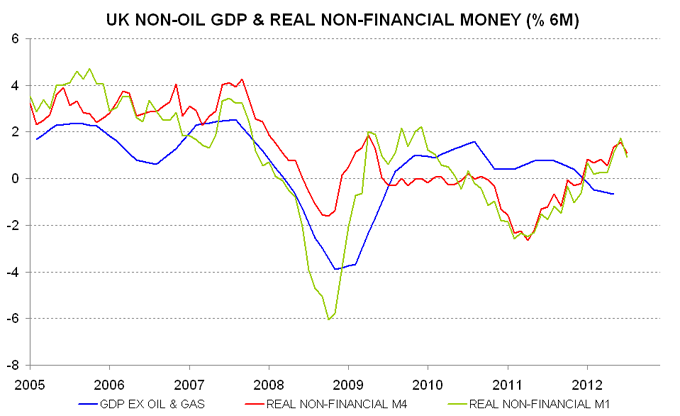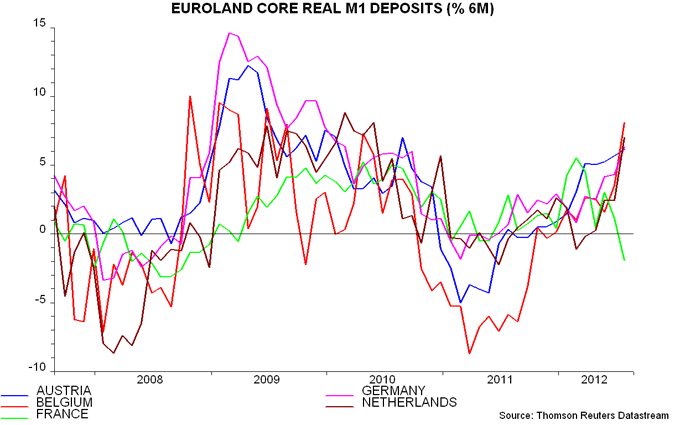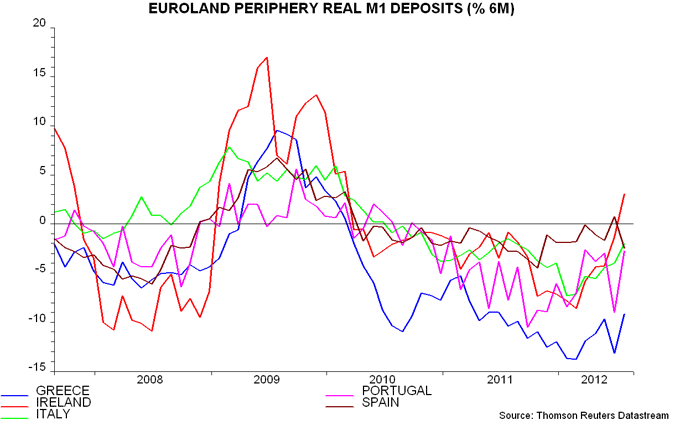Entries from August 26, 2012 - September 1, 2012
UK money acceleration argues against MPC easing
UK monetary trends continue to signal an economic pick-up in late 2012, in contrast to consensus gloom. Stronger nominal money growth, however, will face an increased inflation headwind over coming months, probably preventing further real acceleration. This highlights the economic cost of the Bank of England’s failure to achieve its inflation target.
Underlying monetary trends are arguably best assessed using money supply measures that exclude the volatile holdings of financial corporations. Non-financial M4 and M1 (i.e. covering holdings of households and private non-financial corporations) rose by 4.6% and 4.1% in the 12 months to July – the strongest since September 2008 and July 2010 respectively.
The chart compares the two-quarter change in GDP excluding oil and gas extraction with six-month changes in real non-financial M4 and M1 (i.e. deflated by seasonally-adjusted consumer prices, not annualised). Economic weakness in early 2012 followed real money contraction in 2011. The real money measures have recently expanded at rates last reached in 2009-10 ahead of a period of solid economic growth.
Real money expansion, however, may stabilise or fall back slightly over coming months as inflation rebounds. The inflation forecast presented in a post last week implies that the six-month change in seasonally-adjusted consumer prices will rise from 1.0% in July to 2.1% by January 2013 (not annualised). Nominal money trends may not improve sufficiently to offset this increased drag. Such a scenario would suggest a stabilisation of economic growth next spring following a pick-up over the winter.

Eurozone monetary pick-up signalling German-led recovery
Eurozone monetary statistics for July confirm an improving economic outlook, with six-month growth rates of real M1 and M3 (i.e. deflated by consumer prices) reaching their highest levels since July 2010 and March 2009 respectively. Real M1 is the “best” monetary forecasting indicator of the economy, contracting before the 2008-09 and 2011-12 recessions and rebounding ahead of the intervening recovery – see first chart. It bottomed in April 2012, suggesting that the Eurozone economy will trough this autumn and revive into 2013, allowing for the usual half-year lead.
The turnaround in economic prospects is likely to be missed by a consensus focused on continued weakness in bank lending to the private sector. The money supply is picking up despite credit weakness because of recent bank purchases of government bonds and a shift of funds out of longer-term bank savings instruments into deposits. The latter trend should be sustained following further falls in interest rates and shows that these are working to change behaviour – a transfer of savings into more liquid forms is a precursor of higher spending. Bank buying of government bonds has slowed recently but the ECB’s planned intervention scheme may take up any slack. (Credit usually lags money – in 2008-09, private sector loans bottomed more than a year after M1.)
Real M1 rose by 2.2%, or 4.4% annualised, in the six months to July. M1 comprises currency in circulation and overnight deposits. The ECB provides a country breakdown of deposits but not currency. A 2.1% rise in Eurozone real overnight deposits in the six months to July reflects a strong 4.6% increase in “core” countries offset by a 2.1% decline in the periphery (i.e. Greece, Ireland, Italy, Portugal, Spain) – second chart. Within the core, German real overnight deposits surged by 6.3%, or 13.0% annualised, suggesting that the economy will boom next year – see previous post. French real deposits, by contrast, have contracted recently – third chart.
The continued fall in peripheral real overnight deposits is disappointing, signalling no end to recessions this year, but the decline has – Spain excepted – slowed. Recent and prospective ECB actions promise improvement, in part by lifting confidence, thereby stemming or reversing capital flight. Core / periphery monetary divergence is of less concern when Eurozone-wide real M1 is rising solidly – a gap is desirable to promote economic rebalancing.
The key risk in the current monetary constellation is that prospective German buoyancy results in the Bundesbank and its allies demanding that the ECB rein in stimulus, repeating the 2010-11 policy debacle that laid the foundations for the current recession. ECB President Draghi, however, has skilfully outmanoeuvred the hardliners by designing policies that command strong support – to the extent that the Bundesbank chief is now isolated even from Germany’s representative on the ECB’s executive board.





